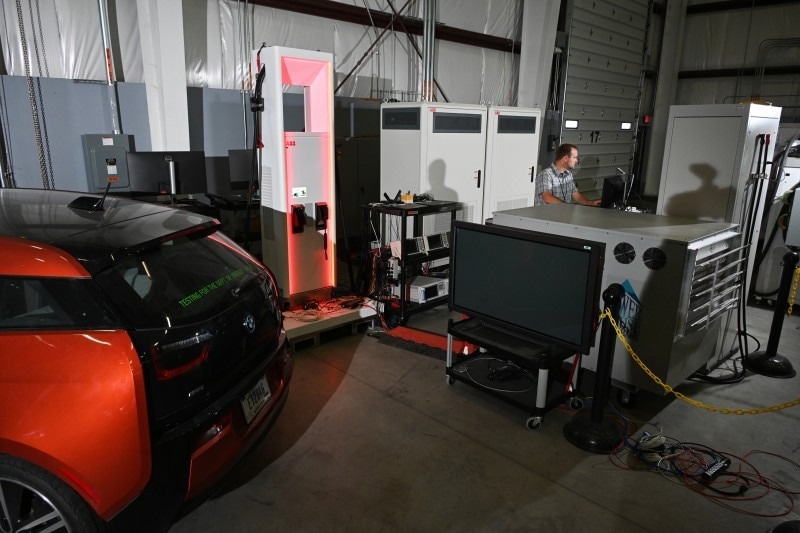The key lies within the materials in order to produce an electric vehicle battery that can charge as swiftly as it takes to fill a car with gasoline.

Faster vehicle charging is a key effort the INL team is trying to enable with NMC811 on cathodes. Image Credit: Idaho National Laboratory
High-nickel, layered-oxide cathode materials can make EV batteries charge quicker, last longer, and go farther. A group headed by Idaho National Laboratory has discovered that cathodes built of a nickel-rich material known as NMC811 (80% nickel, 10% manganese, 10% cobalt) maintain better performance and longer life. While it is not a discrete new chemistry, NMC811 has the potential to provide a way to better performance. The key is to comprehend its properties.
With electric vehicles, the world is at a tipping point. During 2022, 5.8% of the new cars Americans bought were electric, up from 3.2% in 2021. For the first time, the total EV sales topped 800,000. However, one difficulty that is troublesome to the industry is constructing a battery that can charge repeatedly in a timeframe of 10–15 minutes.
Extreme fast charging puts considerable pressure on all components of a battery, and differences in chemistry, electrode and materials engineering could have substantial impacts on performance.
A lithium-ion battery offers power by transporting ions via its electrolytes from the cathode to the anode. Although scientists are beginning to better comprehend lithium plating on anodes, they get less understanding about the extremely fast charging’s effect on cathodes.
In the June 2022 issue of Advanced Energy Materials, INL scientists headed by Tanvir Tanim published a peer-reviewed article. The article described that as the battery industry moves toward higher-nickel-content cathodes, they will require a full understanding of how materials might worsen under extreme fast charging.
The research of the team explains NMC811’s aging behavior under varied fast charging conditions, the most extreme corresponding to over 200,000 miles of driving. The paper related NMC811’s performance to NMC532 (50% nickel, 30% manganese, 20% cobalt), the more predominant material in batteries when the study started over five years ago.
At varied fast charging rates, the INL-led group researched a range of electrochemical methods to test battery cells charged from 35% to 100%. The research concentrated on failure mechanisms, which included how particles mechanically fracture at the time of cycling. To observe how much cracking happened in varied cycling conditions, they utilized advanced scanning electron microscopy methods to analyze the particles’ architecture.
Regarding the two cathode materials, Tanim stated that they were astonished that even though NMC811 displayed considerable subsurface degradation, it displayed superior cycle life performance over NMC532. He partially credited this to the molecules in NMC811 being organized in a way that forms freer lithium-ion pathways.
NMC811 also has higher ionic and electrical conductivity in comparison to NMC532, improving the quantity of charge a battery can hold with recurrent use.
Besides, NMC811 displayed slower impedance growth. Impedance is a measure of internal resistance and is essential because high resistance makes a battery heat up, minimizing voltage and lessening cell capacity to the point where it gets unusable. On demand, a low-impedance battery offers high current.
Altogether, NMC811 displayed higher specific energy—the electrical energy that can be attained from a cell in one discharge cycle divided by the individual cell mass—and improved electrical conductivity than lower nickel-content types. As cobalt is inadequate in quantity and costly, the lower cobalt content of NMC811 also points to minimal cost.
The study done at national laboratories goes to the US Department of Energy, sharing it with the scientific community, the automotive industry, and battery developers. “Some automotive manufacturers have already started using NMC811 on cathodes, making the research particularly relevant,” Tanim said.
Tanim showed that the complicated influence of grain architecture and orientation on single-particle performance will be the aim of future work. However, the research team concluded that cathodes are built of NMC811 could be an improved bet for EV batteries that can charge in 10–15 minutes. “NMC811 will provide more flexibility for optimizing a battery for both high-energy and power,” the paper stated.
Journal Reference
Tanim, T. R., et al. (2022). A Comprehensive Understanding of the Aging Effects of Extreme Fast Charging on High Ni NMC Cathode. Advance Energy Material. https://doi.org/10.1002/aenm.202103712.